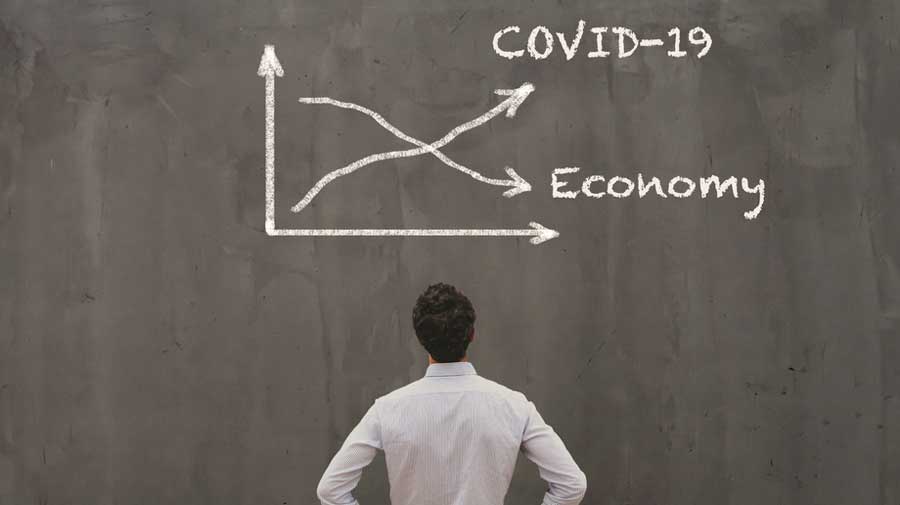Analysts want the government to give a realistic fiscal deficit target for 2021-22 as the coronavirus has dealt a severe blow to its finances this year.
The pandemic has caused the fiscal deficit to surge to Rs 10.75 lakh crore at the end of November, which is equivalent to 135.1 per cent of the 2020-21 budget estimates (BE).
The budget had originally pegged fiscal deficit at Rs 7.96 lakh crore. Fiscal deficit is the difference between the total income of the government and its total expenditure.
The government had invoked the “escape clause” provided in the amended Fiscal Responsibility and Budget Management Act to allow the deficit to rise to 3.8 per cent of GDP in the revised estimates (RE) for 2019-20 from 3.3 per cent of GDP budgeted for the year.
Subsequently, it had expected the fiscal deficit to decline to 3.5 per cent of GDP in the budget estimates (BE) for 2021-22 and 3.3 per cent of GDP in the rolling target for 2022-23. However, the calculations turned awry after the economy was hit by Covid-19.
“According to the first advance estimates of GDP, real GDP will contract 7.7 per cent in 2020-21 and nominal GDP growth is expected at (-) 4.2 per cent. Accordingly, the nominal GDP for 2021-22 would grow 15 per cent to Rs 224.04 lakh crore.
Current trends in the GDP for 2020-21 will translate into a net revenue shortfall of Rs 3.2 lakh crore for the Centre this fiscal, while expenditure will be higher by around Rs 3.3 lakh crore, taking the fiscal deficit to Rs 14.46 lakh crore.
Industry chamber CII said the government should look at “deficit management from a three-year perspective and ensure greater transparency in deficit numbers by giving realistic revenue projections, avoiding off-budget borrowings and... announcing a realistic fiscal deficit target for FY22”.
Former CEA Shankar Acharya said the government should not go too much on the defensive but set a more realistic fiscal deficit target of 4.75-5.25 per cent for 2021-22.
“Since we are talking about a much larger GDP base, this automatically means more fiscal deficit in rupee terms. A 5 per cent deficit should address the issues,” he said.
FY22 (2021-22 will also need additional outlays for vaccine rollout, managing the logistics and prioritising health expenditure... 5 per cent fiscal deficit target for 2021-22, should address the revenue buoyancy, lag effect spending and the COVID outlays,” he said.
It said “for FY22, assuming the government keeps the expenditure growth at 6 per cent over FY21 estimates and overall receipts, excluding borrowing and other liabilities, expected at 25 percent, it would result in a fiscal deficit of around Rs 11.67 lakh crore or 5.2 per cent of GDP.”
Madan Sabnavis, chief economist of Care Ratings said “the first advance estimate of GDP for FY21 and our expectations on the finances of the Central Government, we project Centre’s fiscal deficit at 7.8% of GDP during FY21. On adding the amount borrowed for GST compensation to the states, the fiscal deficit could widen to 8.4% of GDP.”
The government did announce a series of measures to support the pandemic hit economy but the finances remained constrained on the revenue front owing to which they had to resort to borrowings. The Government announced an increase in its gross market borrowings programme by Rs 4.2 lakh crore, taking the total gross borrowings to Rs 12 lakh crore during the year. Additionally, as part of the GST compensation shortfall faced by the states, the Central Government planned to borrow Rs 1.1 lakh crs under a special window and transfer the same to the states.
Though the government announced stimulus measures worth Rs 29.87 lakh crore, the fiscal component of these measures was low since it largely consisted of liquidity provided by the Reserve Bank of India and credit guarantees.
“The revised FY21 budgetary numbers will serve as the basis for fixing the targets for the coming fiscal year. The revised numbers for FY21 will hinge on how much the nation-wide lockdown has weighed on the revenues of the Government, whether the apparent recovery seen in the latter half of the fiscal could materially off-set the loss of revenue in the first half, reorientation of expenditure towards relief, health, capital expenditure in FY21 and cost savings in non-priority departments,” Sabnavis added.
The country’s track record on fiscal consolidation has been rather poor. Though the original aim as per the Fiscal Responsibility and Budget Management Act was to reduce the fiscal deficit to 3.0% of GDP by March 2008, it has been postponed multiple times. As per the fiscal consolidation roadmap, the government was supposed to bring down the fiscal deficit to 3.1% of GDP by 2022-23. For the fiscal roadmap, one will have to wait for the Budget to know the answer.











